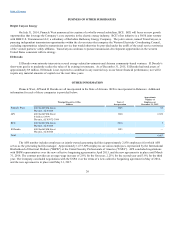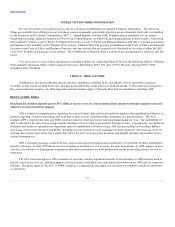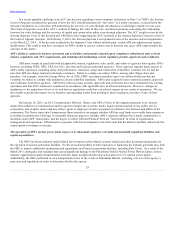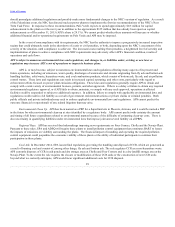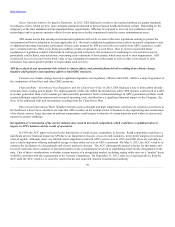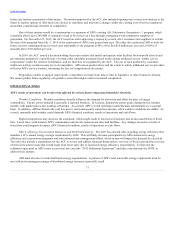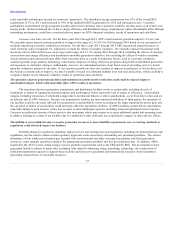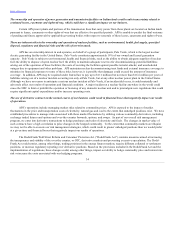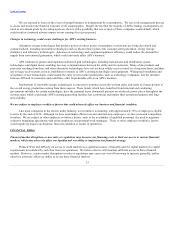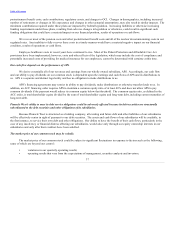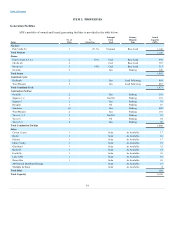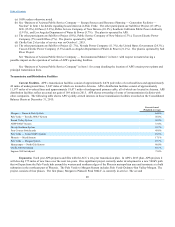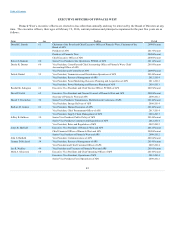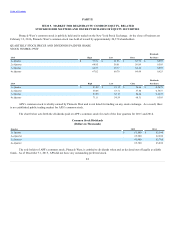APS 2015 Annual Report Download - page 39
Download and view the complete annual report
Please find page 39 of the 2015 APS annual report below. You can navigate through the pages in the report by either clicking on the pages listed below, or by using the keyword search tool below to find specific information within the annual report.
Table of Contents
In addition, the credit commitments of our lenders under our bank facilities may not be satisfied or continued beyond current
commitment periods for a variety of reasons, including new rules and regulations, periods of financial distress or liquidity issues
affecting our lenders or financial markets, which could materially adversely affect the adequacy of our liquidity sources and the cost of
maintaining these sources.
Changes in economic conditions, monetary policy, financial regulation or other factors could result in higher interest rates, which
would increase interest expense on our existing variable rate debt and new debt we expect to issue in the future, and thus reduce funds
available to us for our current plans.
Additionally, an increase in our leverage, whether as a result of these factors or otherwise, could adversely affect us by:
• causing a downgrade of our credit ratings;
• increasing the cost of future debt financing and refinancing;
• increasing our vulnerability to adverse economic and industry conditions; and
• requiring us to dedicate an increased portion of our cash flow from operations to payments on our debt, which would
reduce funds available to us for operations, future investment in our business or other purposes.
A downgrade of our credit ratings could materially and adversely affect our business, financial condition and results of operations.
Our current ratings are set forth in “Liquidity and Capital Resources — Credit Ratings” in Item 7. We cannot be sure that any of
our current ratings will remain in effect for any given period of time or that a rating will not be lowered or withdrawn entirely by a
rating agency if, in its judgment, circumstances in the future so warrant. Any downgrade or withdrawal could adversely affect the
market price of Pinnacle West’s and APS’s securities, limit our access to capital and increase our borrowing costs, which would
diminish our financial results. We would be required to pay a higher interest rate for future financings, and our potential pool of
investors and funding sources could decrease. In addition, borrowing costs under our existing credit facilities depend on our credit
ratings. A downgrade could also require us to provide additional support in the form of letters of credit or cash or other collateral to
various counterparties. If our short-term ratings were to be lowered, it could severely limit access to the commercial paper market. We
note that the ratings from rating agencies are not recommendations to buy, sell or hold our securities and that each rating should be
evaluated independently of any other rating.
Investment performance, changing interest rates and other economic factors could decrease the value of our benefit plan assets and
nuclear decommissioning trust funds and increase the valuation of our related obligations, resulting in significant additional funding
requirements. We are subject to risks related to the provision of employee healthcare benefits and healthcare reform legislation. Any
inability to fully recover these costs in our utility rates would negatively impact our financial condition.
We have significant pension plan and other postretirement benefits plan obligations to our employees and retirees, and legal
obligations to fund nuclear decommissioning trusts for Palo Verde. We hold and invest substantial assets in these trusts that are
designed to provide funds to pay for certain of these obligations as they arise. Declines in market values of the fixed income and equity
securities held in these trusts may increase our funding requirements into the related trusts. Additionally, the valuation of liabilities
related to our pension plan and other postretirement benefit plans are impacted by a discount rate, which is the interest rate used to
discount future pension and other postretirement benefit obligations. Declining interest rates decrease the discount rate, increase the
valuation of the plan liabilities and may result in increases in pension and other
36


